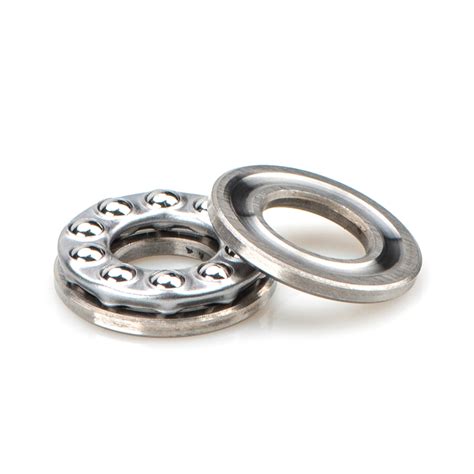The Ultimate Guide to Axial Bearings: Functions, Benefits, and Applications
Introduction
Axial bearings, also known as thrust bearings, are specialized components designed to withstand and transmit axial forces. They play a crucial role in a wide range of machinery and equipment, enabling them to operate smoothly and efficiently. This comprehensive guide delves into the world of axial bearings, exploring their functions, benefits, applications, and key considerations.
Functions of Axial Bearings
Axial bearings primarily serve two essential functions:
-
Support axial loads: They carry and distribute axial forces along their axis of rotation, preventing damage to mating components and ensuring proper alignment.
-
Reduce friction: Axial bearings minimize friction between rotating and stationary surfaces, reducing wear and extending equipment lifespan.
Benefits of Axial Bearings
The use of axial bearings offers numerous benefits:

-
Increased load capacity: These bearings are capable of handling high axial loads, making them suitable for applications such as heavy machinery and automotive transmissions.
-
Reduced friction: Precision-engineered ball or roller elements provide low-friction operation, enhancing efficiency and reducing energy consumption.
-
Improved durability: Axial bearings are designed to withstand harsh operating conditions, ensuring long-term performance and reliability.
-
Compact design: They offer a compact design, allowing for space optimization in machine designs.
-
Low maintenance: Axial bearings are generally low-maintenance components, reducing downtime and operational costs.
Applications of Axial Bearings
Axial bearings find application in a diverse range of industries and applications, including:
-
Automotive: Transmissions, differentials, water pumps
-
Industrial: Cranes, hoists, gearboxes, compressors
-
Aerospace: Jet engines, landing gear
-
Mining: Excavators, conveyors
-
Construction: Tower cranes, concrete mixers
Types of Axial Bearings
Axial bearings are classified into various types based on their design and construction:

-
Ball thrust bearings: Utilize hardened steel balls as rolling elements, providing high load capacity and low friction.
-
Roller thrust bearings: Employ cylindrical or tapered rollers as rolling elements, offering higher load capacity than ball thrust bearings.
-
Angular contact thrust bearings: Feature inclined raceways, allowing for combined axial and radial loads.
-
Fluid film thrust bearings: Lubricated by a thin film of oil or gas, reducing friction and wear at high speeds.
Considerations for Selecting Axial Bearings
When choosing axial bearings, several key factors must be considered:
-
Load capacity: Determine the maximum axial load that the bearing must withstand.
-
Speed: Consider the rotational speed of the application to ensure the bearing is suitable for the operating conditions.
-
Lubrication: Select the appropriate lubrication method to maintain bearing performance and extend lifespan.
-
Environment: Take into account the operating temperature, humidity, and contamination levels to choose a bearing with suitable material and sealing properties.
-
Cost: Evaluate the cost of the bearing in relation to its performance and durability requirements.
How Axial Bearings Matter in Different Industries
Automotive
Axial bearings play a critical role in automotive transmissions and differentials, supporting axial loads and reducing friction. They contribute to smoother gear changes, improved fuel efficiency, and extended transmission life.

Industrial
In industrial machinery, such as cranes and hoists, axial bearings ensure safe and reliable operation by supporting heavy axial loads and maintaining alignment. They enhance lifting capacity, reduce wear, and increase machine uptime.
Aerospace
Axial bearings in jet engines and landing gear are vital for handling extreme axial forces. They enable high thrust and safe landings, ensuring aircraft performance and safety.
Pros and Cons of Axial Bearings
Pros:
- High load capacity
- Low friction
- Durable construction
- Compact design
- Low maintenance
Cons:
- Limited radial load capacity
- Can be more expensive than radial bearings
- Require proper alignment for optimal performance
FAQs
Q: What is the difference between ball and roller thrust bearings?
A: Ball thrust bearings offer higher speeds and lower friction, while roller thrust bearings have a higher load capacity.
Q: How do I determine the correct lubrication method for an axial bearing?
A: Consult the manufacturer's recommendations based on operating conditions, speed, and load.
Q: What are the signs of a failing axial bearing?
A: Unusual noise, vibration, excessive heat, and reduced load capacity.
Q: How can I extend the lifespan of an axial bearing?
A: Proper lubrication, correct alignment, and regular maintenance are essential for maximizing bearing lifespan.
Q: What is the typical lifespan of an axial bearing?
A: The lifespan varies depending on operating conditions, load, and maintenance practices, but can range from several years to decades.

Conclusion
Axial bearings are essential components in various industries, providing crucial support for axial loads and reducing friction. Their high load capacity, low friction, and compact design make them ideal for applications demanding reliable and efficient operation. By understanding the functions, benefits, and considerations of axial bearings, engineers and technicians can optimize machine performance and extend equipment lifespan.

